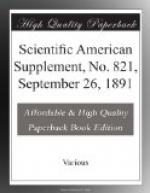The armament of the Marceau is good for the tonnage of the ship and consists principally of four guns of 34 centimeters (13.39 in.) of the French 1884 model, having a weight of 52 tons, a length of 281/2 calibers, and being able to pierce 30 in. of iron armor at the muzzle. The projectiles weigh 924 lb., and are fired with a charge of 387 lb. of powder. The muzzle velocity has been calculated to be 1,968 ft. per second. The guns are entirely of steel and are mounted on Canet carriages in four barbette towers, one forward, one aft, and one on each side amidships. On the firing trials both the guns and all the Canet machinery, for working the guns and hoisting the ammunition, gave very great satisfaction to all present at the time. In addition to the above four heavy guns there are, in the broadside battery, sixteen guns of 14 centimeters (5.51 in.), eight on each side, and a gun of equal caliber is mounted right forward on the same deck. The armament is completed by a large number of Hotchkiss quick-firing and revolver guns and four torpedo tubes, one forward, one aft, and one on each side.
The crew of the Marceau has been fixed at 600 men, and the cost is stated to have been about $3,750,000.—Engineering.
* * * * *
[Continued from supplement, No. 820, page 13097.]
A REVIEW OF MARINE ENGINEERING DURING THE PAST DECADE.[1]
[Footnote 1: Paper read before the Institution of Mechanical Engineers, July 28, 1891.]
BY MR. ALFRED BLECHYNDEN, OF BARROW-IN-FURNESS
Steam Pipes.—The failures of copper steam pipes on board the Elbe, Lahn, and other vessels have drawn serious attention both to the material and to the modes of construction of the pipes. The want of elastic strength in copper is an important element in the matter; and the three following remedies have been proposed, while still retaining copper as the material. First, in view of the fact that in the operation of brazing the copper may be seriously injured, to use solid drawn tubes. This appears fairly to meet the main dangers incidental to brazing; but as solid drawn pipes of over 7 inches diameter are difficult to procure, it hardly meets the case sufficiently. Secondly, to use electrically deposited tubes. At first much was promised in this direction; but up to the present time it can hardly be regarded as more than in the experimental stage. Thirdly, to use the ordinary brazed or solid drawn tubes, and to re-enforce them by serving with steel cord or steel or copper wire. This has been tried, and found to answer perfectly. For economical reasons, as well as for insuring the minimum of torsion to the material during manufacture, it is important to make as few bends as possible; but in practice much less difficulty has been experienced in serving bent pipes in a machine than would have been expected.




